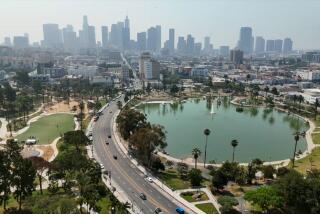Op-Ed: How do you ease traffic in Los Angeles? Make it harder to park
- Share via
Angelenos voted overwhelmingly last month to expand L.A.’s transit network. Measure M passed by a 4-point margin in large part due to Metro’s promise to reduce traffic congestion throughout the county. But while the proposed new rail lines and bus routes will offer additional mobility choices, they will do little to reduce congestion unless Los Angeles also addresses its abundance of parking spaces.
Cities have long required that a minimum number of spaces accompany any new building or one that is “adaptively reused” — changed from a warehouse, say, to lofts. Los Angeles requires 30 spaces for a 3,000-square-foot restaurant and two spaces for a two-bedroom apartment. While drivers like to find parking at their destinations, the data show there can be too much of a good thing.
Decades of car-centric development in Los Angeles have resulted in more than three and a half parking spaces for every car in the county — nearly 19 million in total. These spaces — in residential garages and driveways, commercial parking structures and surface lots, and along streets — account for 200 square miles of real estate, much of it concentrated in dense, transit-friendly areas.
Decades of car-centric development in L.A. have resulted in more than three and a half parking spaces for every car in the county — nearly 19 million in total.
It is not a coincidence that where there’s the greatest concentration of parking spaces —the downtown core, Hollywood and the Wilshire corridor — traffic can be particularly bad. The abundance of cheap or free parking spaces encourages Angelenos to choose cars over other transportation options and creates localized congestion, which makes driving more painful for everyone.
Only by making parking more scarce will we give drivers a reason to switch to buses or subways — and achieve Measure M’s promise of reducing traffic.
L.A. County is expected to add 1.5 million people and 615,200 jobs by 2040. The region’s strategy to handle this growth, minimize overall traffic and reduce greenhouse gas emissions is to focus development in existing neighborhoods near jobs and rapid transit. But if new residential, commercial or mixed-use developments around Measure M projects are held to existing minimum parking requirements, the car will remain the practical choice for many potential transit users.
There are, however, a number of parking policy reforms Los Angeles could enact that would decrease rather than increase the region’s auto-dependency.
One of the most effective ways to cut down on car use and congestion would be to impose maximum parking-space regulations rather than minimums. Setting a low maximum near transit stops would encourage mass transit use, discourage driving and mitigate the localized traffic increases that come with development.
Perhaps more important is limiting parking for new residential buildings. Since the 1970s, the total number of registered passenger cars has been roughly equal to the total number of residential parking spaces. If every new apartment, condo or single-family home has an associated parking spot, new residents and potential transit users are still likely to own a car and use it often despite transit alternatives. Requiring developers to provide less residential parking would reduce per capita auto-use.
Capping the construction of parking spaces near transit and charging renters separately for parking might also make new transit-adjacent housing more affordable, especially for mass transit users. Building fewer parking spaces can significantly cut housing costs — the median construction cost per space is about $50,000.
Los Angeles could, finally, reduce the barriers to shared parking. As it stands, many businesses have to provide parking regardless of hours of operation. A shared parking policy would allow adjacent businesses with alternate operating hours (a coffee shop, say, and dinner-only restaurant) to reduce the total number of spaces provided. Land that’s no longer needed for parking spaces could go to new infill development.
Any change to the existing parking paradigm will be met with resistance. Developers may protest parking limits out of fear that they won’t be able to maximize their profits in selling or leasing housing. Parking-free buildings may create angry neighbors worried about drivers endlessly patrolling their streets for spaces. But strategies such as neighborhood permits can mitigate many of these problems.
Angelenos like to think they have a right to cheap and easy mobility in the form of car ownership. We suggest that cheap and easy accessibility — to work, stores and fun — is the right we should strive to promote.
Ultimately, Los Angeles struggles with congestion because the number of drivers has outpaced space on our roads. There isn’t funding or room to expand the roadway network, and more cars is no one’s idea of a sustainable future. Reducing parking availability near good transit options is arguably the least painful way to address L.A.’s congestion.
Andrew M. Fraser, Mikhail Chester and Juan Matute are the authors, with Ram Pendyala, of “Do Cities Have Too Much Parking?” in the fall issue of Access Magazine.
Follow the Opinion section on Twitter @latimesopinionand Facebook
MORE FROM OPINION
How California’s job standards worsen recidivism
Local polystyrene bans are good; a statewide California ban would be better
In L.A.’s garment industry, ‘Made in the USA’ can mean being paid $3 an hour
More to Read
A cure for the common opinion
Get thought-provoking perspectives with our weekly newsletter.
You may occasionally receive promotional content from the Los Angeles Times.










